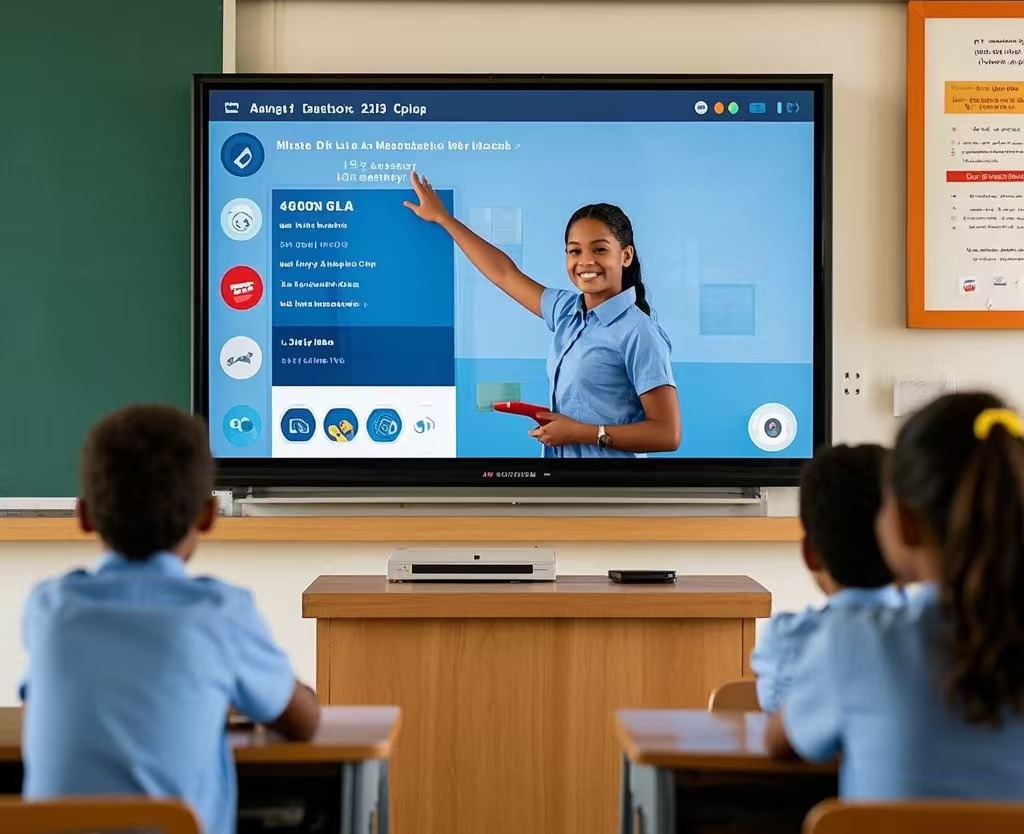Touchscreen TV vs. Traditional TV: What’s the Difference?

When customers first encounter a touchscreen TV, they often ask, “Isn’t this just a regular TV?” At first glance, a touchscreen TV may look similar to a traditional television. However, it offers much more functionality, making it far superior for business and educational environments. A touchscreen TV for classroom or meeting space is not just a display device—it’s an interactive tool that enhances collaboration, productivity, and engagement.
Key Differences Between Touchscreen TVs and Traditional TVs
Although touchscreen TVs and regular televisions might seem similar at first, they have distinct functionalities. Let’s explore their differences in terms of functionality, technology, and applications.
1. Functionality: How Touchscreen TVs Revolutionize Meetings and Classrooms
Touchscreen TVs are built for interaction, making them far more useful than standard TVs. Some of the standout features include:
Wireless Screen Mirroring
A touchscreen TV allows for wireless screen sharing from devices such as computers, smartphones, or tablets. This feature lets users display content across multiple devices simultaneously—perfect for comparing data during meetings or classes.
Whiteboard Capabilities
Unlike traditional TVs, touchscreen TVs enable touch-based writing directly on the screen. This replaces the need for whiteboards or even projectors, offering a digital whiteboard experience. You can effortlessly write, erase, and even insert images or tables to enhance presentations. This touchscreen overlay for TV functionality is essential for interactive meetings, classrooms, and more.
Integrated Video Conferencing
Similar to traditional TVs, touchscreen TVs come with integrated sound systems, but they also include cameras and microphones for video calls. This allows for seamless remote meetings directly from the screen. With touchscreen TVs, the overall user experience is enhanced, offering not just display but interactive capabilities, unlike static televisions.
2. Technology: How Touchscreen TVs Surpass Traditional LCD Displays
The technological gap between touchscreen TVs and traditional televisions is substantial, especially in terms of advanced features.
Superior Technology
Touchscreen TVs incorporate high-definition display technology, interactive interfaces, and internet connectivity, far exceeding the capabilities of a standard TV. This combination of technologies provides an interactive and versatile experience in both professional and educational settings.
Comprehensive Meeting Tools
Traditional LCD TVs are primarily used for display purposes and lack interactive functionalities. In contrast, touchscreen TVs integrate multiple devices such as computers, projectors, whiteboards, and large display screens into a single solution, making them more cost-effective and efficient for team collaboration.
Ease of Use
Unlike a touchscreen mirror TV or standard television, which requires additional equipment for full functionality (e.g., HDMI cables or external devices), touchscreen TVs offer easy plug-and-play operation. No complicated setups or installations are necessary—just simple training to get started.
3. Application Versatility: Why Touchscreen TVs Are Ideal for Diverse Uses
A touchscreen TV for classroom or office meetings brings incredible value. Let’s compare how touchscreen TVs offer more than just the display function of traditional TVs:
Convenient Projection
A traditional LCD TV is a static device with limited connectivity options, often requiring cables like HDMI or VGA. On the other hand, touchscreen TVs can wirelessly display content from multiple devices, offering much more flexibility. Additionally, touchscreen TVs provide the added benefit of interactive whiteboarding—making them perfect for brainstorming sessions or teaching environments.
Operating System Compatibility
Many touchscreen TVs support Android systems, and some even offer the option to integrate Windows or other operating systems, allowing easy use of a variety of software. Unlike regular LCD TVs, which are limited in functionality, a touchscreen TV provides an all-in-one solution for diverse digital needs.
Device Compatibility
Traditional TVs are often limited in their compatibility with other devices due to their lack of an operating system. In contrast, touchscreen TVs support a range of third-party devices, making them more adaptable in various settings—whether you’re adding touchscreen to TV for your team or integrating it into a classroom setup.
Recording Capabilities
One of the standout features of touchscreen TVs is the ability to record and save meeting notes directly from the screen. This is especially useful for both professional and educational environments. You can even email or share the notes after the meeting using QR code scanning or direct email functionalities. Traditional televisions, by contrast, don’t offer these capabilities, requiring you to use external devices like physical whiteboards or note-taking software.
The Versatile Benefits of Adding Touchscreen to Your TV
By adding a touchscreen overlay for TV, you can transform any conventional television into an interactive touchscreen TV. This simple enhancement allows you to write, draw, and interact directly on the screen—making it a powerful tool for presentations, remote work, and educational sessions.
Where to Buy the Best Touchscreen TVs
If you are looking to equip your office, classroom, or conference room with the best touchscreen TV for classroom use or meeting setups, make sure to check our official website for top-quality interactive displays. We offer a wide range of solutions, including touchscreen mirror TVs and more! Visit our website for detailed product specifications and purchasing options.
Conclusion: Why Choose a Touchscreen TV Over a Traditional TV?
While traditional televisions have their place, touchscreen TVs are far more versatile and interactive, making them ideal for modern business meetings, classrooms, and collaborative environments. With features like wireless screen mirroring, whiteboard capabilities, and video conferencing integration, a touchscreen TV is far more than just a display—it’s an interactive hub that boosts productivity and communication.
To further enhance your workspace or classroom, consider adding touchscreen to TV technology. Whether you’re looking to buy a touchscreen mirror TV or a touchscreen TV for classroom, the added interactivity and functionality will greatly improve your setup.
Learn more about the incredible features of a touchscreen TV and how it can transform your business meetings or educational space.
By integrating the latest technology into your workspace, you’ll see an immediate impact on collaboration and engagement. Whether for business meetings or classroom teaching, touchscreen TVs offer unmatched versatility compared to traditional televisions.


